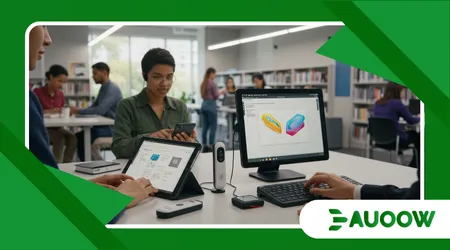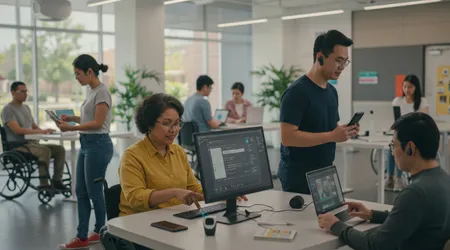How Assistive Tech Is Bridging the Digital Divide

Assistive tech is bridging the digital divide by empowering underserved communities with tools for equitable access to digital resources, fostering inclusion in an increasingly connected world.
Imagine a visually impaired student navigating an e-learning platform with ease or a rural entrepreneur managing an online business via voice-activated software.
These scenarios, once distant dreams, are now reality, thanks to innovations that dismantle barriers to technology access. As we stand in 2025, the digital divide a gap separating those with reliable tech access from those without remains a pressing issue.
Yet, assistive technologies are proving to be game-changers, offering solutions that transcend physical, economic, and geographic limitations.
This article explores how these innovations are reshaping lives, supported by real-world examples, current data, and a vision for a more inclusive digital future.
Why shouldn’t everyone have a fair shot at the opportunities technology offers?
The Digital Divide: A Persistent Challenge
The digital divide persists as a global challenge, excluding millions from the benefits of technology. In underserved regions, limited internet access stifles economic growth.
For people with disabilities, inaccessible devices create additional hurdles.
According to a 2025 report from the Center for Financial Inclusion at Accion, micro and small enterprises adopting digital tools are 10% more likely to report revenue growth, yet usage remains low in emerging markets.
This gap fuels inequality, as access to digital platforms becomes essential for education, work, and civic participation.
Economic barriers, like the high cost of devices, deepen this divide. Rural areas often lack reliable broadband infrastructure, isolating communities.
++ Real-Time Captioning Tools You Need to Know About
For individuals with disabilities, standard interfaces may be unusable without specialized adaptations. These challenges interlock, creating cycles of exclusion that assistive tech seeks to break.
The stakes are high: without intervention, the divide risks perpetuating poverty and marginalization. Assistive technologies, however, offer targeted solutions, enabling access where traditional systems fall short.
By addressing specific needs, these tools create pathways to inclusion, transforming how people engage with the digital world.

Assistive Technologies: Tools for Empowerment
Assistive tech is bridging the digital divide by providing tailored solutions for diverse needs. Screen readers, like JAWS, convert text to speech for visually impaired users.
Voice-activated assistants, such as Google Assistant, enable hands-free device control, benefiting those with mobility challenges. These innovations make digital spaces navigable, empowering users to participate fully.
Consider Maria, a visually impaired teacher in rural Brazil. Using a screen reader, she accesses online educational platforms to teach remotely, connecting with students globally.
Such tools dismantle barriers, turning inaccessible interfaces into opportunities for engagement and growth.
Also read: The Future of Smart Wheelchairs: What’s Coming Next
Beyond individual use, assistive tech supports community-wide access. Low-cost devices with built-in accessibility features, like text-to-speech, are now reaching underserved areas, enabling broader participation in digital economies and education.
AI-Powered Innovations in Accessibility
Artificial intelligence is revolutionizing assistive tech, making digital access more intuitive. AI-driven tools, like real-time captioning, assist deaf users in virtual meetings.
Natural language processing (NLP) enables seamless communication for those with speech impairments. Assistive tech is bridging the digital divide by adapting to unique user needs in real time.
Take the example of Ben Snyder, a student with a learning disability.
AI tools help him break down complex texts and organize tasks, leveling the academic playing field. These advancements ensure that technology adapts to users, not vice versa.
AI also powers predictive text and voice recognition, simplifying interactions for users with motor disabilities.
Read more: How Haptic Feedback Enhances Accessibility in Gaming
In 2025, platforms like Gemini Live integrate camera and screen-sharing capabilities, offering free, accessible assistance across devices, including iOS, enhancing inclusivity.
| Assistive Technology | Function | Impact |
|---|---|---|
| Screen Readers (e.g., JAWS) | Converts text to speech | Enables visually impaired users to navigate digital platforms |
| Voice Assistants (e.g., Alexa) | Hands-free device control | Supports users with mobility challenges |
| AI Captioning Tools | Real-time subtitles | Facilitates communication for deaf users |
| NLP-Based Tools | Simplifies text, aids speech | Enhances accessibility for learning and speech disabilities |
Bridging Rural and Urban Gaps
Assistive tech is bridging the digital divide in rural areas, where connectivity remains a hurdle. Mobile apps with offline capabilities allow farmers to access market data without reliable internet.
Voice-activated tools bypass literacy barriers, enabling broader participation in digital economies.
In India, where internet users surpassed 900 million in 2025, regional content in local languages drives rural adoption.
Assistive tech, like text-to-speech in Hindi, empowers non-English speakers to engage with digital platforms, fostering economic inclusion.
Community partnerships amplify these efforts. Lenovo’s philanthropy, aiming to impact 15 million lives by 2025, donates accessible devices to rural schools, transforming education.
Such initiatives show how targeted interventions can close geographic divides.
Rural telehealth platforms also benefit from assistive tech. AI-driven virtual assistants provide medical guidance in remote areas, reducing healthcare disparities. These tools ensure that distance no longer dictates access to essential services.
Education: Leveling the Playing Field
For students with disabilities, assistive tech is bridging the digital divide by making education accessible.
AI tools simplify complex texts, aiding students with learning disabilities. Real-time translation software supports multilingual learners, breaking language barriers in classrooms.
An example is Aisha, a deaf student in Canada. Using AI-powered captioning, she participates in virtual lectures, engaging with peers effortlessly. Such technologies ensure equitable access to education, a cornerstone of social mobility.
Digital literacy programs also leverage assistive tech. iSisters Technology Mentoring, highlighted at Canada’s 2025 Digital Access Day, trains underserved women in tech skills, using accessible tools to foster inclusion.
These efforts empower marginalized groups to thrive in digital spaces.
Yet, challenges remain. Lower-income students often lack access to advanced AI tools, creating a secondary divide.
Addressing this requires scalable, affordable solutions to ensure equitable educational opportunities.
Healthcare: Enhancing Access and Equity
Assistive tech is bridging the digital divide in healthcare, particularly for underserved populations.
Telemedicine platforms with AI-driven assistants offer personalized care to remote communities. Remote patient monitoring (RPM) tools track chronic conditions, reducing hospital visits.
In Australia, a 2024 SOTI report emphasized tech upgrades for healthcare efficiency.
Assistive tools, like voice-activated medical apps, enable patients with mobility issues to manage appointments independently, enhancing autonomy.
Community partnerships further this impact. By providing internet access and devices, organizations ensure equitable care delivery.
Assistive tech is bridging the digital divide by making healthcare inclusive, regardless of location or physical ability.
However, disparities persist. Rural clinics often lack the infrastructure for advanced tools, underscoring the need for investment in connectivity and affordable devices to sustain progress.
Economic Empowerment Through Accessibility
Accessible technologies drive economic inclusion by enabling entrepreneurship and job opportunities. Assistive tech is bridging the digital divide for small businesses in emerging markets.
Mobile banking apps with voice navigation allow visually impaired entrepreneurs to manage finances independently.
Consider Kwame, a Ghanaian vendor with motor disabilities. Using an accessible e-commerce platform, he sells crafts globally, boosting his income. Such tools empower individuals to participate in digital economies, reducing poverty.
Yet, adoption lags in low-income regions due to cost and awareness barriers. Scaling assistive tech requires subsidies and education to ensure widespread economic benefits.
Training programs also play a role. By teaching digital skills with accessible tools, organizations like Accion empower micro-entrepreneurs, fostering self-reliance and economic growth in underserved communities.
The Role of Policy and Philanthropy

Governments and organizations are pivotal in scaling assistive tech. India’s 2025 Union Budget aims to boost rural internet penetration, supporting accessible tech deployment.
Assistive tech is bridging the digital divide through policy-driven infrastructure improvements.
Philanthropic efforts, like Lenovo’s goal to transform one million lives by 2025, provide devices and training to underserved groups. These initiatives amplify the reach of assistive technologies, driving systemic change.
Public-private partnerships are equally critical. By funding accessible tech development, governments and corporations ensure sustainable solutions that address diverse needs across communities.
Still, policy gaps remain. Inconsistent regulations and funding shortages hinder progress, requiring coordinated global efforts to prioritize accessibility in digital infrastructure plans.
Challenges and Future Directions
Despite progress, barriers to assistive tech adoption persist. High costs limit access for low-income users, deepening inequities.
In rural areas, unreliable internet hampers tool effectiveness. Assistive tech is bridging the digital divide, but scalability remains a challenge.
Technical limitations also pose issues. Speech recognition struggles with accents or impairments, excluding some users. Continuous innovation is needed to make tools universally accessible and intuitive.
Looking ahead, affordability and infrastructure must improve. Governments and tech firms should prioritize open-source solutions and subsidies to ensure assistive tech reaches all who need it.
Emerging trends, like AI-enhanced wearables showcased at CES 2025, promise greater accessibility. These innovations could further democratize access, provided they are affordable and widely distributed.
A Vision for an Inclusive Digital Future
Assistive tech is bridging the digital divide, weaving a more inclusive digital tapestry.
By empowering individuals with disabilities, rural communities, and underserved groups, these tools unlock opportunities in education, healthcare, and economic participation.
The journey, however, is far from over. As technology evolves, so must our commitment to accessibility, ensuring no one is left behind.
Think of assistive tech as a bridge over a turbulent river, connecting isolated communities to a world of possibilities.
With continued investment, innovation, and collaboration, this bridge can grow stronger, wider, and more accessible.
The 10% revenue growth for digitally enabled businesses in emerging markets is a testament to the transformative power of accessible tech.
Yet, the true measure of success lies in the lives changed students learning, patients cared for, and entrepreneurs thriving.
The digital divide is not just a technological gap; it’s a barrier to human potential.
By championing assistive technologies, we can build a future where everyone has a seat at the digital table. Let’s keep pushing because an inclusive world is within our reach.
Frequently Asked Questions
Q: What is assistive technology?
A: Assistive technology includes devices and software, like screen readers and voice assistants, designed to help people with disabilities access digital platforms.
Q: How does assistive tech help rural communities?
A: It provides offline-capable tools and language-specific interfaces, enabling access to education, healthcare, and economic opportunities despite limited connectivity.
Q: Are assistive technologies affordable for low-income users?
A: Costs remain a barrier, but subsidies, open-source solutions, and philanthropy are making these tools more accessible to underserved groups.
Q: Can assistive tech fully close the digital divide?
A: While it significantly narrows the gap, broader infrastructure and policy support are needed for universal access and equity.
Q: What role do governments play in assistive tech adoption?
A: Governments fund infrastructure, regulate accessibility standards, and partner with organizations to deploy assistive tech in underserved areas.
